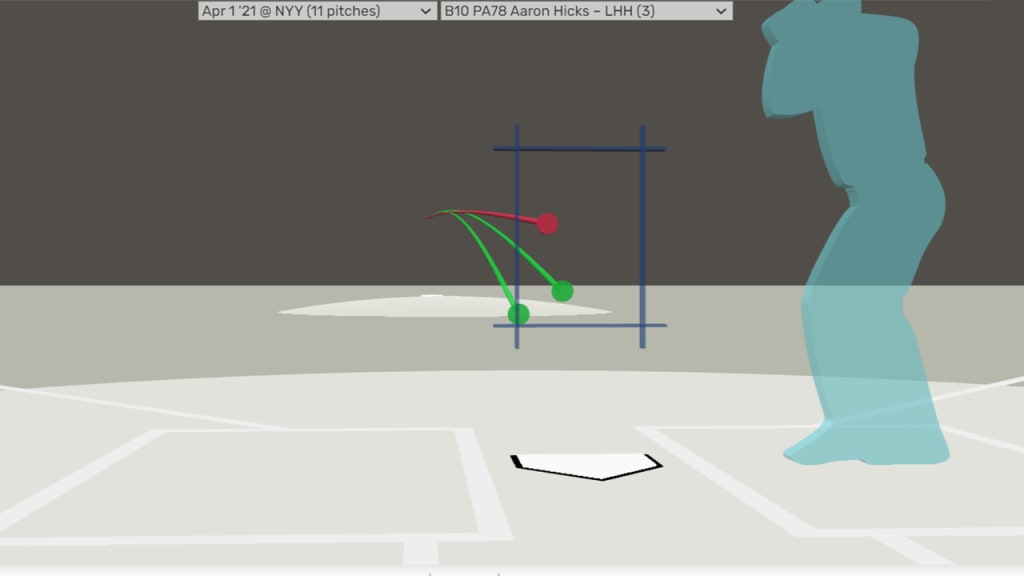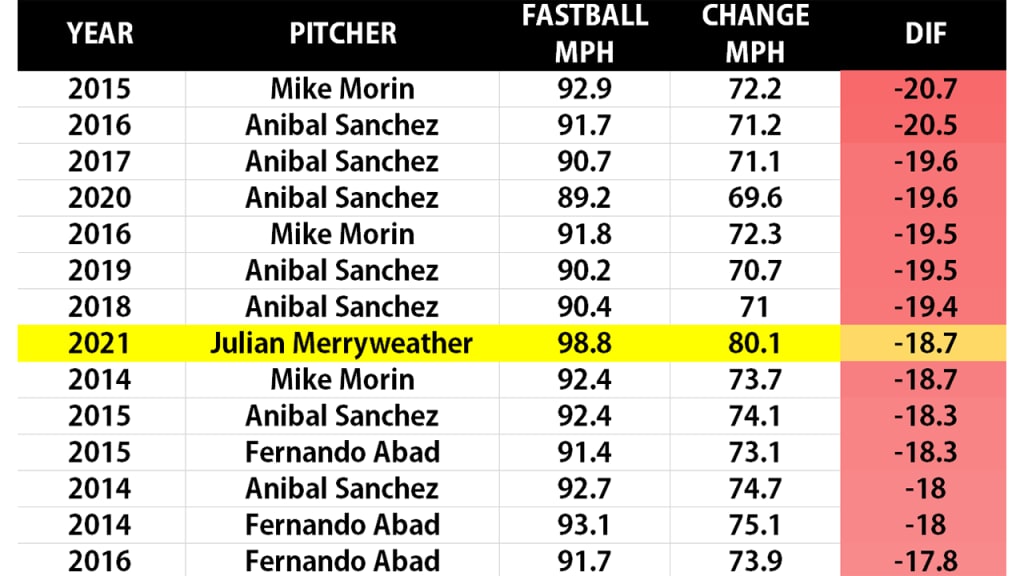Less than a week into the season, you know how misleading stat lines can be. Jack Flaherty probably won’t have a 12.46 ERA all year. Josh Hader probably won’t keep up a 100% strikeout rate all year. (Well, maybe.) But there are a few things that are worth looking at, even this early on, like changes in velocity or movement, or even just opportunity. We can’t say for sure that any of these guys are the next Craig Kimbrel or Kenley Jansen, but we can comfortably say that they’re considerably more interesting than they were just a week ago.
Pitchers, more than hitters, are particularly fascinating in this regard, because you can learn more about them more quickly than you can anyone else. That is: You can't fake throwing 100 mph. You can't luck into a nasty curveball. It's worth noting that on Opening Day 2020, you didn't know who Devin Williams was, and he won the National League Rookie of the Year Award, thanks to his fabulous "airbender." At the end of this year, we might be able to say we saw stardom coming for one of these arms this quickly.
(All numbers current through Tuesday afternoon.)
Julian Merryweather, RHP, Blue Jays
If there’s an early relief star of the 2021 season, it’s Merryweather, who was acquired from Cleveland in 2018 as the player to be named in the Josh Donaldson deal. He’d already missed all of ‘18 due to Tommy John surgery, then pitched only 19 pro innings over the next two seasons. But on Opening Day, he struck out three Yankees on 11 pitches. On Sunday, he struck out two more Yankees on 11 more pitches. More important, he looked unbelievable doing it. Who is this guy?
It stood out, obviously, that he has been averaging 98.8 mph on his fastball, a considerable jump from the 96.7 mph he had in a brief stint with the Blue Jays last year. Then again, it seems like everyone throws 98 these days. By itself, the velocity doesn’t stand out. But what does is how it pairs with his changeup.
Just look at what he did to a good hitter in Aaron Hicks on Opening Day, when he went 96.7 mph for a first-pitch strike, then 80.1 for a changeup and 78.7 for another changeup, perfectly dotted on the outside corner. Hicks watched all three. He had no idea what to do with any of them.
Look at it from a 3D perspective. Look how perfectly that last changeup is placed. What do you even do with that, after seeing 97 mph on the first pitch?

Usually, you’ll see a fastball/changeup velocity difference in the 8-10 mph range. But this is nearly 20 mph, which seems like a lot, and so, of course, we had to ask: Is there precedent for this? What other pitchers have had two pitches like that?
So we went back to the start of the pitch-tracking era in 2008, finding seasons where pitchers had thrown at least 100 four-seamers and 25 changeups. Through '20, there were nearly 4,000 such seasons. Only two pitchers had a larger gap than Merryweather. (We’re showing his '21 on here, but his '20 season -- when he had a 16 mph gap -- isn’t much further down.)

But, wait a second. Sánchez is a soft-tosser. So were Morin and Abad. Merryweather is out there doing this at nearly 99 mph. So if we look for only pitchers averaging 98 or more, we can say that no one in the pitch-tracking era has ever had a four-seam/changeup gap of at least 15 mph. This is potentially a big deal for a Toronto bullpen that lost Kirby Yates before he ever took the mound.
Wes Benjamin, LHP, Rangers
Benjamin was a fifth-round pick back in 2014, and he moved slowly up the Rangers' farm system before making his debut last year with 22 1/3 decent-but-not-terribly-interesting innings. We took notice over the winter when he started speaking some heavily analytical lingo, though that also barely stands out much these days.
But when he made his season debut on Sunday, throwing 2 1/3 innings of scoreless relief against the Royals, we definitely noticed this:
2020 four-seam velocity: 90.9 mph
2021 four-seam velocity: 93.4 mph
That's one of the largest early velocity increases in the game. Where, exactly, did that come from? Benjamin already had a fastball that had top-20 rise last season -- that’s the bat-missing vertical movement boasted by Trevor Bauer, Liam Hendriks, Walker Buehler and so on -- and a quick peak at his 2021 numbers suggests that hasn’t gone anywhere; it’s actually become a little better.
“The characteristics of it are elite,” said Texas skipper Chris Woodward. “It’s special.”
Plus, at the risk of putting too much into a handful of curveballs, there appears to be increased movement there, too. (Just look at this one.) Benjamin may end up more of a tandem reliever than a late-inning closer, but there’s reason to pay close attention to him.
Mac Sceroler, RHP, Orioles
Let's get deep. Sceroler, a nephew of former Orioles pitcher Ben McDonald, was a Rule 5 Draft pick by the Orioles from the Reds over the winter. That's either good or bad, depending on how you look at it, because the Cincinnati organization has turned itself into a real pitching powerhouse, so you could argue his availability is either "the Reds were just too overstuffed with good pitchers" or "a pitching-factory team thought he was worth letting go." Maybe it's a little of both.
Either way, it was interesting to hear how Orioles scouting director Mike Snyder talked about what they liked in Sceroler.
“We were attracted to the four-pitch mix,” Snyder said. “It’s a good fastball, good traits and flashes of power. He leverages the curveball downhill and throws the slider for strikes and for chases. He can get a lot of awkward swings on a plus splitter.”
When it came time to give him a shot, Baltimore absolutely did not ease him in, because his Major League debut came against Aaron Judge ... in Yankee Stadium ... with the bases loaded. To his credit, Sceroler struck Judge out. He got Hicks to pop out to end the inning. He ended up retiring the first seven Yankees he saw, before walking a pair. And that "plus splitter" that Snyder talked about? Well, it looked pretty good here:
Based on the extremely-really-very-early numbers, Sceroler's fastball would have top-10 rise (by 2019 stats) and his curveball would have top-30 drop. Again, he's pitched one game. But you also don't need a whole lot of sample size to see how a pitch moves, either.
Chris Rodriguez, RHP, Angels
Like Merryweather, Rodriguez hasn’t pitched a whole lot lately. Due to back problems and the pandemic, the only time you could have seen him on a pro mound over the last three years would have been if you’d caught one of the three games he pitched in for Class A Advanced Inland Empire in 2019. That’s it, though, of course, he was also throwing at the team’s alternate training site in '20.
Despite that lack of experience, he made the team’s Opening Day roster, and he’s pitched twice in a long-man role. (It remains somewhat unclear what the team’s long-term plans for him might be, but it's hard to see him pitching starter-length innings in the near future after his recent history.)
“[Rodriguez’s] stuff is that good. We think he can be a difference maker,” said Angels manager Joe Maddon before the season, and he's struck out three in each of his two appearances so far, though he's also been a little too hittable. But when he's going right, he's got a 96.8 mph sinker with some movement on it, which just looks so uncomfortable to face:
That's paired with an 85 mph breaker that looks like this. A curve at 85 is no joke; it is, over the last few years, about as hard as anyone throws their curveball. We've said endlessly, for years, that the Angels need more pitching, and generally that's been pointing to the rotation, or lack of one. But it can't all be external additions, and it can't all be on Shohei Ohtani's shoulders. If Mike Trout and friends are ever going to go back to the playoffs, they'll need pitchers like Rodriguez to help get them there, too.
Tyler Matzek, LHP, Braves
We’re cheating a little here, because Matzek isn’t really “new” at all. He’s 30 years old. He was drafted in the first round wayyyyy back in 2009, the same year that Stephen Strasburg, Trout, and James Paxton were picked. But after a pair of relatively unremarkable years with the Rockies in 2014-’15, Matzek found himself out of affiliated baseball, and as recently as '19, he was pitching for the Texas AirHogs of the American Association. But he resurfaced with the Braves last summer, and this year, he made his first Opening Day roster in six years.
Matzek pitched twice against the Phillies in Atlanta's opening series, and while the Braves might not have been successful in Philadelphia, he raised more than a few eyebrows when he touched 100.2 mph while striking out Alec Bohm. It’s not just the velocity that stood out, though it was surely that too; it was how perfectly he placed it.
Since 2018, only eight other left-handed pitchers have touched 100 mph. (Unsurprisingly, Aroldis Chapman leads the list, having done so an absurd 342 times.) Also worth noting: Matzek has increased his curveball velocity (from 79.1 to 82.5) and his slider velocity (from 82.9 to 86.1), each by a lot. But he’s managed to do that without losing any vertical break, which is a big deal; throwing harder means there’s simply less time for the ball to drop. That tracks with the big spin rate increase he’s shown early on, too.
As it always is with Matzek, it’ll come down to whether he can throw enough strikes. But so far, there’s a lot to like about a pitcher who, a dozen years on, might finally look like the first-round pick Colorado thought he was back in 2009.
